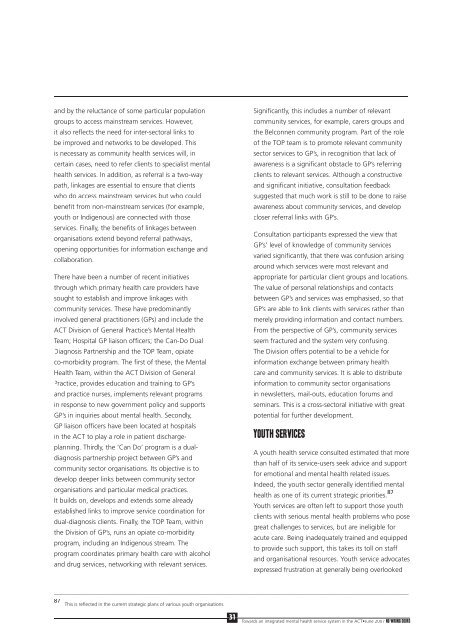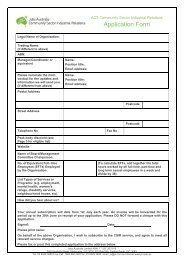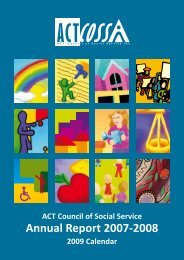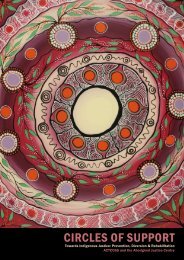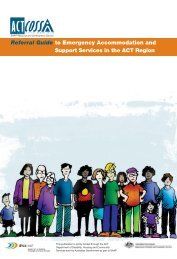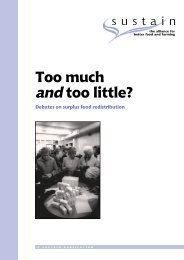actcoss text final.indd - ACT Council of Social Service
actcoss text final.indd - ACT Council of Social Service
actcoss text final.indd - ACT Council of Social Service
You also want an ePaper? Increase the reach of your titles
YUMPU automatically turns print PDFs into web optimized ePapers that Google loves.
and by the reluctance <strong>of</strong> some particular population<br />
groups to access mainstream services. However,<br />
it also reflects the need for inter-sectoral links to<br />
be improved and networks to be developed. This<br />
is necessary as community health services will, in<br />
certain cases, need to refer clients to specialist mental<br />
health services. In addition, as referral is a two-way<br />
path, linkages are essential to ensure that clients<br />
who do access mainstream services but who could<br />
benefit from non-mainstream services (for example,<br />
youth or Indigenous) are connected with those<br />
services. Finally, the benefits <strong>of</strong> linkages between<br />
organisations extend beyond referral pathways,<br />
opening opportunities for information exchange and<br />
collaboration.<br />
There have been a number <strong>of</strong> recent initiatives<br />
through which primary health care providers have<br />
sought to establish and improve linkages with<br />
community services. These have predominantly<br />
involved general practitioners (GPs) and include the<br />
<strong>ACT</strong> Division <strong>of</strong> General Practice’s Mental Health<br />
Team; Hospital GP liaison <strong>of</strong>ficers; the Can-Do Dual<br />
Diagnosis Partnership and the TOP Team, opiate<br />
co-morbidity program. The first <strong>of</strong> these, the Mental<br />
Health Team, within the <strong>ACT</strong> Division <strong>of</strong> General<br />
Practice, provides education and training to GP’s<br />
and practice nurses, implements relevant programs<br />
in response to new government policy and supports<br />
GP’s in inquiries about mental health. Secondly,<br />
GP liaison <strong>of</strong>ficers have been located at hospitals<br />
in the <strong>ACT</strong> to play a role in patient dischargeplanning.<br />
Thirdly, the ‘Can Do’ program is a dualdiagnosis<br />
partnership project between GP’s and<br />
community sector organisations. Its objective is to<br />
develop deeper links between community sector<br />
organisations and particular medical practices.<br />
It builds on, develops and extends some already<br />
established links to improve service coordination for<br />
dual-diagnosis clients. Finally, the TOP Team, within<br />
the Division <strong>of</strong> GP’s, runs an opiate co-morbidity<br />
program, including an Indigenous stream. The<br />
program coordinates primary health care with alcohol<br />
and drug services, networking with relevant services.<br />
Significantly, this includes a number <strong>of</strong> relevant<br />
community services, for example, carers groups and<br />
the Belconnen community program. Part <strong>of</strong> the role<br />
<strong>of</strong> the TOP team is to promote relevant community<br />
sector services to GP’s, in recognition that lack <strong>of</strong><br />
awareness is a significant obstacle to GP’s referring<br />
clients to relevant services. Although a constructive<br />
and significant initiative, consultation feedback<br />
suggested that much work is still to be done to raise<br />
awareness about community services, and develop<br />
closer referral links with GP’s.<br />
Consultation participants expressed the view that<br />
GP’s’ level <strong>of</strong> knowledge <strong>of</strong> community services<br />
varied significantly, that there was confusion arising<br />
around which services were most relevant and<br />
appropriate for particular client groups and locations.<br />
The value <strong>of</strong> personal relationships and contacts<br />
between GP’s and services was emphasised, so that<br />
GP’s are able to link clients with services rather than<br />
merely providing information and contact numbers.<br />
From the perspective <strong>of</strong> GP’s, community services<br />
seem fractured and the system very confusing.<br />
The Division <strong>of</strong>fers potential to be a vehicle for<br />
information exchange between primary health<br />
care and community services. It is able to distribute<br />
information to community sector organisations<br />
in newsletters, mail-outs, education forums and<br />
seminars. This is a cross-sectoral initiative with great<br />
potential for further development.<br />
YOUTH SERVICES<br />
A youth health service consulted estimated that more<br />
than half <strong>of</strong> its service-users seek advice and support<br />
for emotional and mental health related issues.<br />
Indeed, the youth sector generally identified mental<br />
health as one <strong>of</strong> its current strategic priorities. 87<br />
Youth services are <strong>of</strong>ten left to support those youth<br />
clients with serious mental health problems who pose<br />
great challenges to services, but are ineligible for<br />
acute care. Being inadequately trained and equipped<br />
to provide such support, this takes its toll on staff<br />
and organisational resources. Youth service advocates<br />
expressed frustration at generally being overlooked<br />
___________________________________________________________________________________________________________________________<br />
87 This is reflected in the current strategic plans <strong>of</strong> various youth organisations.<br />
31<br />
Towards an integrated mental health service system in the <strong>ACT</strong>•June 2007 NO WRONG DOORS


